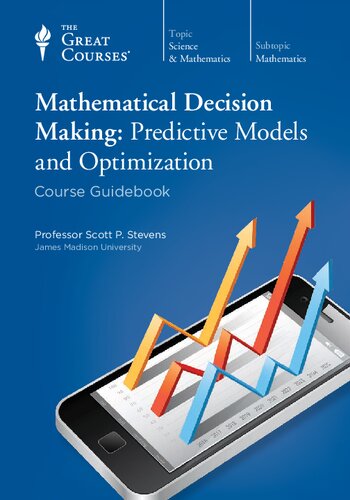

Most ebook files are in PDF format, so you can easily read them using various software such as Foxit Reader or directly on the Google Chrome browser.
Some ebook files are released by publishers in other formats such as .awz, .mobi, .epub, .fb2, etc. You may need to install specific software to read these formats on mobile/PC, such as Calibre.
Please read the tutorial at this link: https://ebookbell.com/faq
We offer FREE conversion to the popular formats you request; however, this may take some time. Therefore, right after payment, please email us, and we will try to provide the service as quickly as possible.
For some exceptional file formats or broken links (if any), please refrain from opening any disputes. Instead, email us first, and we will try to assist within a maximum of 6 hours.
EbookBell Team

4.7
26 reviewsNot so long ago, executives faced with complex problems made decisions based on experience, intuition, and no small measure of luck. But now there’s a better way. In recent decades, mathematics and computer science have perfected formerly top-secret techniques for predicting the best possible outcomes when faced with conflicting options. This field goes by different names—analytics, operations research, linear and nonlinear programming, management science—but its purpose is simple: to apply quantitative methods to help business managers, public servants, investors, scientific researchers, and problem solvers of all kinds make better decisions.
Consider the following applications of this powerful set of tools:
These same techniques can be applied to retirement planning, stock portfolio analysis, budget forecasting, health care allocation, public relations, marketing and advertising, and many other tasks for enterprises large and small. The applications are truly endless!
Mathematical decision making got its first rigorous tests during World War II, when the Allies used top-secret operations research to protect convoys, improve the aim of anti-aircraft fire, and locate the weak points on Allied bombers. After the war, private industry adopted operations research with enthusiasm, but these new methods were expensive, computing speed was slow, and only specialized experts could take advantage of the algorithms. That situation has changed dramatically, and today anyone with a home computer and a spreadsheet program can harness the power of these methods to solve practical problems. The trick is knowing what you can do and how to do it.
Mathematical Decision Making: Predictive Models and Optimization is your guide, teaching you the major mathematical techniques, applications, and spreadsheet procedures for basic analytics in 24 information-packed half-hour lectures. Your professor is award-winning educator Scott Stevens, Professor of Computer Information Systems and Business Analytics at James Madison University.
Those who will benefit from Professor Stevens’s engaging presentation include:
Discover the Art of Deciding
You’ll find that the challenge of analytics is not the math, which is often surprisingly easy, but the wide choice of procedures you have at your fingertips. The art is picking the most effective one to apply to your problem, and this is what Professor Stevens walks you through in fascinating detail. All that’s needed is a willingness to use simple equations. Moreover, you’ll see how modern spreadsheets take the drudgery out of finding solutions, and they make setting up and visualizing problems simple and straightforward.
Mathematical Decision Making is vividly illustrated with graphs, charts, diagrams, and computer animations, which greatly aid understanding the material. In addition, Professor Stevens demonstrates the importance of cultivating your visual intuition. This is particularly helpful when you move from linear programming to nonlinear programming, where effects of synergy and interaction can have strong impact on the bottom line. He shows how you can visualize this new world as a landscape, and then use your natural intuition to decide how best to approach the problem. As an illustration, you see how the fight between Blu-Ray and HD DVD for dominance in the high-definition video market can be pictured as a hyperbolic paraboloid—a saddle-shaped figure—with all of the possible outcomes of the competition mapped onto its surface.
Conveniently, the course guidebook includes additional thought-provoking questions, problems, and answers for each lecture, along with recommended resources to help you dig deeper into any topic where you want to know more.
Analyze a Wealth of Cases
The beauty of this course is that it features case after case of real-life examples. Among the many you’ll explore are these:
An acclaimed instructor who practices what he teaches, Professor Stevens has pushed the boundaries of mathematical decision making on many fronts. His research has addressed such problems as neural network prediction of survival in trauma patients and how to optimize the market for natural gas from the Gulf of Mexico.
Above all, he loves mathematics and the wonders it can perform. “Math is an absolutely beautiful thing,” he marvels. “I’m at my happiest when I can get someone else to see just a piece of that. It’s lovely, structured, consistent, reliable, surprising, enticing, exotic. It’s a great world!” With Mathematical Decision Making, see for yourself how mathematics can make the everyday world we all inhabit a more comprehensible and much better place.